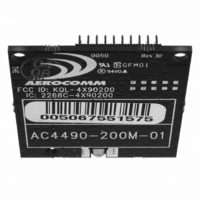AC4490-200M Laird Technologies, AC4490-200M Datasheet - Page 16

AC4490-200M
Manufacturer Part Number
AC4490-200M
Description
TXRX 900MHZ 3.3-5.5V TTL 200MW
Manufacturer
Laird Technologies
Series
AeroCommr
Specifications of AC4490-200M
Frequency
902MHz ~ 928MHz
Data Rate - Maximum
115.2kbps
Modulation Or Protocol
FHSS, FSK
Applications
AMR, Fire & Security Alarms, Telemetry
Power - Output
5mW ~ 200mW
Sensitivity
-110dBm
Voltage - Supply
3.3V, 5V
Current - Transmitting
68mA
Data Interface
Connector, 2 x 10 Header
Antenna Connector
MMCX
Operating Temperature
-40°C ~ 85°C
Package / Case
Module
Output Power
200 mW
Antenna
Integral and External Dipole
Lead Free Status / RoHS Status
Contains lead / RoHS non-compliant
Memory Size
-
Current - Receiving
-
Lead Free Status / Rohs Status
Lead free / RoHS Compliant
Other names
AC4490-200M-01
1 0
T H E O R Y O F O P E R A T I O N
A P I C O N T R O L
API Control is a powerful feature that the AC4490 offers. When enabled, the API Receive Packet, API Transmit Packet,
API Send Data Complete and Enhanced API Receive Packet features provide dynamic packet routing and packet
accounting ability to the OEM Host, thereby eliminating the need for extensive programming on the OEM Host side.
This ability of the protocol makes it ideal for any legacy system. API operation utilizes specific packet formats;
specifying various vital parameters used to control radio settings and packet routing on a packet-by-packet basis.
The API features can be used in any combination that suits the OEM’s specific needs.
R e c e i v e A P I P a c k e t
Implemented in v6.3 of the firmware and later. Receive API Packet can be enabled to determine the sender of a
message. This causes the radio to append a header to the received packet detailing the length of the data packet and
the sender’s MAC address. The Receive API Packet will follow the following format.
Note: If Receive API is enabled, the Enhanced API Receive feature should be disabled by clearing bit-0 of EEPROM
address 0xC6.
A P I T r a n s m i t P a c k e t
Implemented in v6.7 of the firmware and later. API Transmit Packet is a powerful command that allows the OEM Host
to send data to a single or multiple (broadcast) transceivers on a packet-by-packet basis. This can be useful for many
applications; including polling and/or mesh networks. Refer to the API Appendix for further details.
API Transmit Packet is enabled when bit-1 of the Enhanced API Control byte is enabled. The OEM Host should use
the following format to transmit a packet over the RF.
A P I S e n d D a t a C o m p l e t e
Implemented in v6.7 of the firmware and later. API Send Data complete can be used as a software acknowledgement
indicator. When a radio sends an addressed packet, it will look for a received acknowledgement (transparent to OEM
Host). If an acknowledgement is not received, the packet will be retransmitted until one is received or all retries have
been used.
API Send Data Complete is enabled when bit-2 of the Enhanced API Control byte is enabled. The transceiver sends
the OEM Host the following data upon receiving an RF acknowledge or exhausting all attempts.
0x81
1
2
3
1
2
If the OEM Host does not encode the header correctly, the transceiver will send the entire string (up
to 80 bytes) and will look for the header in the next data.
Although the 7 bytes of overhead are not sent over the RF, they are kept in the buffer until the packet
is sent. Keep this in mind so as not to overrun the 256-byte buffer.
Setting the MAC to 0xFF 0xFF 0xFF will broadcast the packet to all available transceivers.
RSSI* is how strong the local transceiver heard the remote transceiver.
Successful RF Acknowledge updates the Success/Failure bit.
Payload Data
(0x01 - 0x50)
Length
0x82
0x83
Aerocomm
Aerocomm
Payload
Length
Use
Data
Use
Retries/Broadcast
Sender’s
MAC
RSSI*
Attempts
Transmit
Payload Data
0x01: Success
0x00: Failure
MAC (2,1,0)
Destination
Payload
Data
















